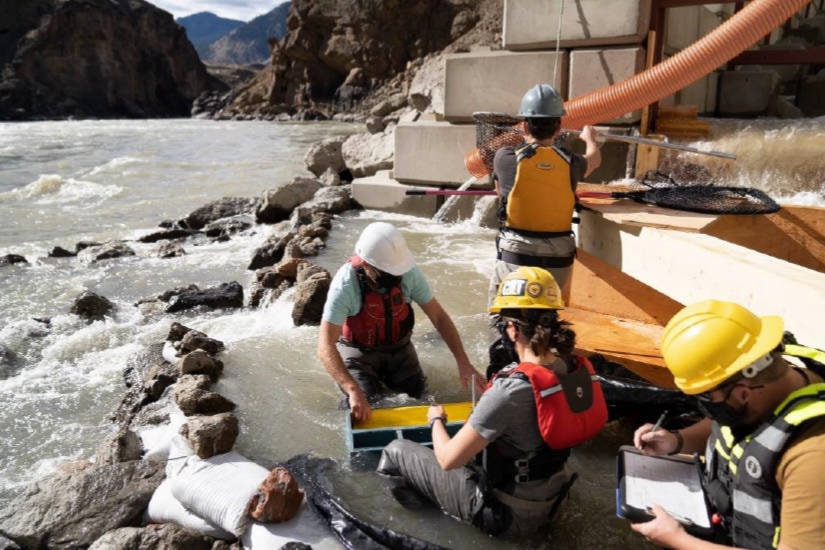Work will begin this winter on a $176-million permanent fishway at the site of the Big Bar landslide, ensuring salmon and steelhead populations will continue to reach their spawning grounds in the upper Fraser River.
Completion of the design and construction work is expected for the start of the 2022 Fraser River salmon migration when river levels are high and fish are least likely to make it past the site on their own.
In a statement today (Dec. 9) Bernadette Jordan, minister of fisheries, oceans and the Canadian Coast Guard, said the fish passage is the latest achievement of an “all hands-on deck” effort to overcome tremendous challenges at the site.
“We are thrilled that construction will soon begin on a permanent fishway. This is a long-term, sustainable solution that will not only protect, but help revive, our wild salmon populations in the Fraser River to their former abundance.”
The 2018 landslide dropped 110,000 cubic metres of rock into the river north of Lillooet, blocking critical passage for spawning salmonids. Ongoing recovery efforts include blasting and debris removal, radio tagging and the Whooshh portal — the so-called salmon canon, which uses pressurized water and tubes to ferry fish past the slide site.
The fishway was the favoured solution over continued blasting and dredging that officials previously said contained too many environmental and engineering uncertainties.
Work on the fishway will begin immediately to take advantage of low river levels in winter.
In a virtual press conference today, Gwill Roberts, director of the Big Bar landslide response for DFO said construction will be challenged by extreme weather and narrow, windy gravel roads in the area.
“Particular problems on the river floor are also there,” he said. “We need a consistent elevation change from the entrance and exit of this fishway, but we find on the north end we start to lose ground, which makes installation that much more challenging.”
The fishway will also need to be large enough to handle high volumes of fish, but not so large it blocks waterflow.
READ MORE:
The design and construction contract was awarded to Peter Kiewit Sons, who previously received a $17.6-million contract for remediation and road-building work. That contract was later amended to $70 million for additional work to support fish passage, which included widening the river channel and constructing a temporary fishway.
The government said the company’s involvement was instrumental to improving unprecedented migration conditions through the canyon in both 2019 and during this year’s 100- to 120-year flooding event that on some days exceeded levels ever recorded on the Fraser.
“This year was very difficult for the fish,” Roberts said. “We had a slowdown in the migration of salmon. They were delayed and their [energy] reserves were depleted.
“[The floods] also affected our operations … they worked, but they were constrained and constricted due to the high water. But the important part to highlight there is the work completed by Kiewit earlier in the year was successful in reducing flows and allowing a lot of the salmon to move by naturally.”
B.C.’s new parliamentary secretary for fisheries and aquaculture, Fin Donnelly, said the B.C. government is dedicated to a permanent solution at Big Bar and will work with federal and First Nations partners to ensure the fishway’s success.
“All three levels of government have been collaborating to restore this site and the permanent fishway will be a significant addition to this ongoing work,” he said.
The Whooshh portal and manual transport operations will remain active during the fishway’s construction.
DFO said they will also continue emergency conservation enhancement efforts for at-risk upper Fraser salmon stocks, in collaboration with Indigenous groups, academics and other experts. Last year those efforts led to the hatchery release of 20,000 early Stuart sockeye fry. Next year DFO expects to release 120,000 more, in addition to 12,000 Bowron sockeye and 68,000 juvenile chinook.
To date this year more than 161,000 salmon migrated on their own past the Big Bar landslide site. Approximately 8,200 fish were moved by the Whooshh system and 1,500 by truck and transport.
Prior to the landslide many of the stocks were already in critical condition, and being considered for listing under the Species at Risk Act (SAR). Michael Crow, DFO’s manager of biological programs for the Big Bar landslide response said an impediment to fish health and habitat like the slide will factor into future assessments for SAR listing and other endangered species initiatives.
READ MORE:




